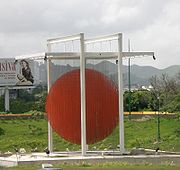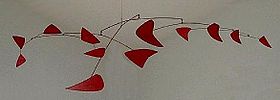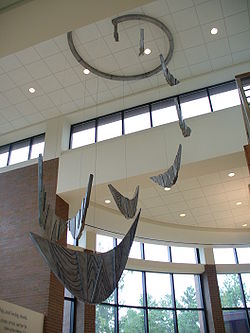
Kinetic art
Encyclopedia

Moving parts
The moving parts of a machine are those parts of it that move. Machines comprise both moving and fixed parts. The moving parts have controlled and constrained motions....
or depends on motion for its effect. The moving parts are generally powered by wind, a motor or the observer. Kinetic art encompasses a wide variety of overlapping techniques and styles.
Kinetic sculpture



Sculpture
Sculpture is three-dimensional artwork created by shaping or combining hard materials—typically stone such as marble—or metal, glass, or wood. Softer materials can also be used, such as clay, textiles, plastics, polymers and softer metals...
or three dimensions. In common with other types of kinetic art, kinetic sculptures have parts that move or that are in motion. Sound sculpture
Sound sculpture
Sound sculpture is an intermedia and time based art form in which sculpture or any kind of art object produces sound, or the reverse...
can also, in some cases, be considered kinetic sculpture. The motion of the work can be provided in many ways: mechanically through electricity
Electricity
Electricity is a general term encompassing a variety of phenomena resulting from the presence and flow of electric charge. These include many easily recognizable phenomena, such as lightning, static electricity, and the flow of electrical current in an electrical wire...
, steam
Steam
Steam is the technical term for water vapor, the gaseous phase of water, which is formed when water boils. In common language it is often used to refer to the visible mist of water droplets formed as this water vapor condenses in the presence of cooler air...
or clockwork
Clockwork
A clockwork is the inner workings of either a mechanical clock or a device that operates in a similar fashion. Specifically, the term refers to a mechanical device utilizing a complex series of gears....
; by utilizing natural phenomena such as wind or wave power; or by relying on the spectator to provide the motion, by doing something such as cranking a handle.
Bicycle Wheel
Bicycle Wheel
Bicycle Wheel is a readymade by Marcel Duchamp consisting of a bicycle fork with front wheel mounted upside-down on a wooden stool.In 1913 at his Paris studio he mounted the bicycle wheel upside down onto a stool, spinning it occasionally just to watch it. Later he denied that its creation was...
(1913) by Marcel Duchamp
Marcel Duchamp
Marcel Duchamp was a French artist whose work is most often associated with the Dadaist and Surrealist movements. Considered by some to be one of the most important artists of the 20th century, Duchamp's output influenced the development of post-World War I Western art...
, is said to be the first kinetic sculpture. Besides being an example of kinetic art it is also an example of a readymade, a type of art of which Marcel Duchamp made a number of varieties throughout his life. In Moscow in 1920, kinetic art was recorded by the sculptors Naum Gabo
Naum Gabo
Naum Gabo KBE, born Naum Neemia Pevsner was a prominent Russian sculptor in the Constructivism movement and a pioneer of Kinetic Art.-Early life:...
and Antoine Pevsner
Antoine Pevsner
Antoine Pevsner was a Belarusian and Russian sculptor and the older brother of Alexii Pevsner and Naum Gabo. Both Antoine and Naum are considered pioneers of twentieth-century sculpture.Pevsner was born in Klimavichy, Belarus...
in their Realist Manifesto, issued as part of a manifesto of constructivism
Constructivist architecture
Constructivist architecture was a form of modern architecture that flourished in the Soviet Union in the 1920s and early 1930s. It combined advanced technology and engineering with an avowedly Communist social purpose. Although it was divided into several competing factions, the movement produced...
.
László Moholy-Nagy
László Moholy-Nagy
László Moholy-Nagy was a Hungarian painter and photographer as well as professor in the Bauhaus school. He was highly influenced by constructivism and a strong advocate of the integration of technology and industry into the arts.-Early life:...
(1895-1946), a member of the Bauhaus
Bauhaus
', commonly known simply as Bauhaus, was a school in Germany that combined crafts and the fine arts, and was famous for the approach to design that it publicized and taught. It operated from 1919 to 1933. At that time the German term stood for "School of Building".The Bauhaus school was founded by...
, and influenced by constructivism
Constructivism (art)
Constructivism was an artistic and architectural philosophy that originated in Russia beginning in 1919, which was a rejection of the idea of autonomous art. The movement was in favour of art as a practice for social purposes. Constructivism had a great effect on modern art movements of the 20th...
can be regarded as one of the fathers of Lumino kinetic art. Light sculpture and moving sculpture are the components of his Light-Space Modulator (1922–30), One of the first Light art
Light art
Light art is a form of visual art where main media of expression is light. Light has been used for architectural aesthetical effects throughout human history. However, the modern concept of light art emerged with the development of artificial light sources and experimenting modern art...
pieces which also combines kinetic art.
The 1950s and 1960s are seen as a golden age of kinetic sculpture, during which time Alexander Calder
Alexander Calder
Alexander Calder was an American sculptor and artist most famous for inventing mobile sculptures. In addition to mobile and stable sculpture, Alexander Calder also created paintings, lithographs, toys, tapestry, jewelry and household objects.-Childhood:Alexander "Sandy" Calder was born in Lawnton,...
and George Rickey
George Rickey
George Rickey was an American kinetic sculptor.Rickey was born on June 6, 1907 in South Bend, Indiana.-Life and work:...
pioneered kinetic sculpture. Other leading exponents include Yaacov Agam
Yaacov Agam
Yaacov Agam is an Israeli sculptor and experimental artist best known for his contributions to optical and kinetic art.-Biography:Yaakov Agam was born Yaakov Gipstein on May 11, 1928, in Rishon LeZion, then Mandate Palestine...
, Fletcher Benton
Fletcher Benton
Fletcher Benton is a kinetic artist from San Francisco, California.-Life:He graduated from Miami University, Oxford, Ohio with a Bachelor of Fine Arts degree in 1956...
, Eduard Bersudsky, Marcel Duchamp
Marcel Duchamp
Marcel Duchamp was a French artist whose work is most often associated with the Dadaist and Surrealist movements. Considered by some to be one of the most important artists of the 20th century, Duchamp's output influenced the development of post-World War I Western art...
, Arthur Ganson
Arthur Ganson
Arthur Ganson is a renowned kinetic sculptor. Ganson makes mechanical art demonstrations and Rube Goldberg machines with existential themes. Ganson has held residencies in science museums, collaborated with the Studebaker Movement Theatre, and been featured in one-man shows at the MIT Museum,...
, Starr Kempf
Starr Kempf
Starr Gideon Kempf was a sculptor, architect, and artist best known for his graceful steel wind kinetic sculptures.- Life :...
, Jerome Kirk, Len Lye
Len Lye
Len Lye, born Leonard Charles Huia Lye , was a Christchurch, New Zealand-born artist known primarily for his experimental films and kinetic sculpture. His films are held in archives such as the New Zealand Film Archive, British Film Institute, Museum of Modern Art in New York City, and the Pacific...
, Ronald Mallory
Ronald Mallory
Ronald Mallory is an artist who worked in New York and now lives in Mexico. In the sixties he was one of the foundational members of the kinetic art movement. In particular, his works involving mercury and acrylic have become icons, and are represented in many collections, including the Museum of...
, Jean Tinguely
Jean Tinguely
Jean Tinguely was a Swiss painter and sculptor. He is best known for his sculptural machines or kinetic art, in the Dada tradition; known officially as metamechanics...
, and the Zero group (initiated by Otto Piene
Otto Piene
Otto Piene is a German artist. He lives and works in Düsseldorf and Groton, Massachusetts.-Biography:...
and Heinz Mack
Heinz Mack
Heinz Mack is a German artist. Together with Otto Piene he founded the ZERO movement in 1957. He exhibited works at documenta in 1964 and 1977 and he represented Germany at the 1970 Venice Biennale. He is best known for his contributions to op art, light art and kinetic art.- Biography :Heinz Mack...
).
Jean Tinguely
Jean Tinguely
Jean Tinguely was a Swiss painter and sculptor. He is best known for his sculptural machines or kinetic art, in the Dada tradition; known officially as metamechanics...
's kinetic junk sculpture Homage to New York in 1960 destroyed itself in the Museum of Modern Art
Museum of Modern Art
The Museum of Modern Art is an art museum in Midtown Manhattan in New York City, on 53rd Street, between Fifth and Sixth Avenues. It has been important in developing and collecting modernist art, and is often identified as the most influential museum of modern art in the world...
's outdoor sculpture garden. Metamechanics
Metamechanics
Metamechanics has a specific meaning in relation to art history, as a description of the kinetic sculpture machines of Jean Tinguely...
has a specific meaning in relation to art history
Art history
Art history has historically been understood as the academic study of objects of art in their historical development and stylistic contexts, i.e. genre, design, format, and style...
, as a description of the kinetic sculpture machines of Jean Tinguely. It is also applied to, and may have its origins in, earlier work of the Dada
Dada
Dada or Dadaism is a cultural movement that began in Zurich, Switzerland, during World War I and peaked from 1916 to 1922. The movement primarily involved visual arts, literature—poetry, art manifestoes, art theory—theatre, and graphic design, and concentrated its anti-war politics through a...
art movement
Art movement
An art movement is a tendency or style in art with a specific common philosophy or goal, followed by a group of artists during a restricted period of time, or, at least, with the heyday of the movement defined within a number of years...
.
Some kinetic sculptures are wind-powered as are those of Theo Jansen
Theo Jansen
Theo Jansen is a Dutch artist and kinetic sculptor. He builds large works which resemble skeletons of animals, that are able to walk using wind power on the beaches of the Netherlands...
(including beach 'animals'), and others are motor driven as are those of Sal Maccarone
Sal Maccarone
Sal Maccarone is a American author, woodworking seminar speaker, furniture maker, wood sculptor and kinetic artist. He is best known as a master craftsman, and for his internationally distributed woodworking books such as Tune Up Your Tools, ISBN 1-55870-409-4, and How to Make $40,000 a Year...
. The kinetic aspect of the Maccarone sculptures are contained within a fine wood cabinet which itself is stationary
Stationary
Stationary can mean:* In statistics and probability: a stationary process.* In mathematics: a stationary point.* In mathematics: a stationary set.* In physics: a time-invariant quantity, such as a constant position or temperature....
. These sculptures turn themselves on and off at pre-determined intervals sometimes catching viewers by surprise. Video.
A mobile
Mobile (sculpture)
A mobile is a type of kinetic sculpture constructed to take advantage of the principle of equilibrium. It consists of a number of rods, from which weighted objects or further rods hang. The objects hanging from the rods balance each other, so that the rods remain more or less horizontal...
is a type of kinetic sculpture constructed to take advantage of the principle of equilibrium. It consists of a number of rods, from which weighted objects or further rods hang. The objects hanging from the rods balance each other, so that the rods remain more or less horizontal. Each rod hangs from only one string, which gives it freedom to rotate about the string. A popular creator of mobile sculptures was Alexander Calder
Alexander Calder
Alexander Calder was an American sculptor and artist most famous for inventing mobile sculptures. In addition to mobile and stable sculpture, Alexander Calder also created paintings, lithographs, toys, tapestry, jewelry and household objects.-Childhood:Alexander "Sandy" Calder was born in Lawnton,...
.
Kinetic drawing
Kinetic drawing makes use of the critical balance and creates 3D drawings from various materials. Kinetic means that the object holds energy, kinetic drawings usually are critical in their stability and are eager to find a more stable position, through gravity. From there they are built up again, better and stronger and with a repetition of this process a beauty of its own starts to grow by natural forces.A variation of kinetic art in the realm of painting is ModulArt
ModulArt
Modular art is art created by joining together standardized units to form larger, more complex compositions. In some works the units can be subsequently moved, removed and added to – that is, modulated – to create a new work of art, different from the original or ensuing configurations.- Origins...
, where smaller modular elements allow a larger painting to be in flux, though not continuously but at the will of its creator, owner, or user. However, the painting stays is motion, offering alternative views and alternative interpretations.
Vehicles: art cars and kinetic sculpture races
An art carArt car
An art car is a vehicle that has had its appearance modified as an act of personal artistic expression. Art cars are often driven and owned by their creators, who are sometimes referred to as "Cartists"....
can be considered a kinetic sculpture by definition, in that it is a piece of art that moves by a petroleum-powered engine.
A kinetic sculpture race
Kinetic sculpture race
Kinetic sculpture races are organized contests of human-powered amphibious all-terrain works of art. The original event, the Kinetic Grand Championship in Humboldt County, California, is also called the "Triathlon of the Art World" because art and engineering are combined with physical endurance...
is an organized contest of human-powered amphibious all-terrain works of art. The original and longest race is held annually since 1969 in Humboldt County
Humboldt County, California
Humboldt County is a county in the U.S. state of California, located on the far North Coast 200 miles north of San Francisco. According to 2010 Census Data, the county’s population was 134,623...
in far northern California. Participants compete for three days over 42 miles of land, water, sand, and mud. Other races are held annually in locations throughout the United States, and in Australia
Australia
Australia , officially the Commonwealth of Australia, is a country in the Southern Hemisphere comprising the mainland of the Australian continent, the island of Tasmania, and numerous smaller islands in the Indian and Pacific Oceans. It is the world's sixth-largest country by total area...
.
External links
- Kinetic Art Organization (KAO) - KAO - Largest International Kinetic Art Organisation (Kinetic Art film and book library, KAO Museum planned)

